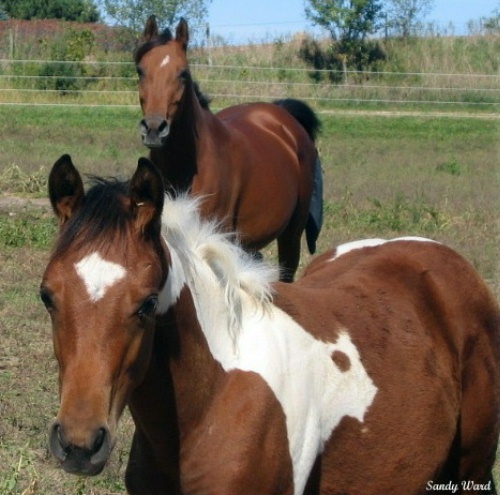

The horse is a hoofed (ungulate) mammal, a subspecies of one of seven extant species of the family Equidae. The horse has evolved over the past 45 to 55 million years from a small multi-toed creature into the large, single-toed animal of today. Humans began to domesticate horses around 4000 BC, and their domestication is believed to have been widespread by 3000 BC; by 2000 BC the use of domesticated horses had spread throughout the Eurasian continent. Although most horses today are domesticated, there are still endangered populations of the Przewalski's Horse, the only remaining true wild horse, as well as more common feral horses which live in the wild but are descended from domesticated ancestors.
There is an extensive, specialized vocabulary used to describe equine-related concepts, covering everything from anatomy to life stages, size, colors, markings, breeds, locomotion, and behavior. Horses are anatomically designed to use speed to escape predators, and have a well-developed sense of balance and a strong fight-or-flight instinct. Related to this need to flee from predators in the wild is an unusual trait: horses are able to sleep both standing up and lying down. Female horses, called mares, carry their young for approximately 11 months, and a young horse, called a foal, can stand and run shortly following birth. Most domesticated horses begin training under saddle or in harness between the ages of two and four. They reach full adult development by age five, and have an average lifespan of between 25 and 30 years.
Horse breeds are loosely divided into three categories based on general temperament: spirited "hot bloods" with speed and endurance; "cold bloods", such as draft horses and some ponies, suitable for slow, heavy work; and "warmbloods", developed from crosses between hot bloods and cold bloods, often focusing on creating breeds for specific riding purposes, particularly in Europe. There are over 300 breeds of horses in the world today, developed for many different uses.
Horses and humans interact in many ways, not only in a wide variety of sport competitions and non-competitive recreational pursuits, but also in working activities including police work, agriculture entertainment, assisted learning and therapy. Horses were historically used in warfare. A wide variety of riding and driving techniques have been developed, using many different styles of equipment and methods of control. Many products are derived from horses, including meat, milk, hide, hair, bone, and pharmaceuticals extracted from the urine of pregnant mares. Humans provide domesticated horses with food, water and shelter, as well as attention from specialists such as veterinarians and farriers.




Horse racing


Horse racing is an equestrian sport that has been practiced over the centuries; the chariot races of Roman times are an early example, as is the contest of the steeds of the god Odin and the giant Hrungnir in Norse mythology. It is often inextricably associated with gambling. The common sobriquet for Thoroughbred horse racing is The Sport of Kings.

Types of racing
The style of racing, the distances and the type of events varies very much by the country in which the race is occurring, and many countries offer different types of horse races.
In the United States, Thoroughbred flat races are run on surfaces of either dirt, polytrack or turf; other tracks offer Quarter Horse racing and Standardbred horse racing, or combinations of these three types of racing surfaces. Racing with other breeds, such as Arabian horse racing, is found on a limited basis. American Thoroughbred races are run at a wide variety of distances, most commonly from 5 to 12 furlongs (0.63 to 1.5 mi; 1.0 to 2.4 km); with this in mind, breeders of Thoroughbred race horses attempt to breed horses that excel at a particular distance.
Important races
The high point of US horse racing has traditionally been the Kentucky Derby. It forms the Triple Crown of Thoroughbred Racing for three-year-olds - together with the Preakness Stakes run at Pimlico Race Course in Baltimore, Maryland, and the Belmont Stakes held at Belmont Park on Long Island. They are all held early in the year. Yet in recent years the Breeders' Cup races, ran at the end of the year, have been challenging the Triple Crown events as determiners of the three-year-old Champion. The Breeders' Cup is held at a different track every year; the most recent edition (2008) was held at Santa Anita. It also has an important effect on the selection of other annual Champions. The corresponding Standardbred event is the Breeders' Crown. There are also a Triple Crown of Harness Racing for Pacers and a Triple Crown of Harness Racing for Trotters, as well as an Arabian Triple Crown consisting of Drinkers of the Wind Derby in California, the Texas Six Shooter Srakes, and the Bob Magness Derby in Deleware.
Thoroughbred and Arabian fillies have their own "Triple" series, commonly referred to as The Triple Tiara. Though there is some disagreement over which three races make up the Triple Tiara of Thoroughbred Racing, the Arabian list is more formal and consists of Daughters of the Desert Oaks in California, the Texas Yellow Rose Stakes, and the Cre Run Oaks in Delaware.
Betting
American betting on horse racing is sanctioned and regulated by the state the racetrack is located in. Simulcast betting almost always exist across state lines with no oversight except the companies involved through legalized parimutuel gambling. A takeout, or "take", is removed from each betting pool and distributed according to state law, among the state, race track and horsemen. On average, 17 percent is withheld from win, place and show pools, with 83 percent being returned to the winning players.
Pakistan
Horse races are held in Pakistan at three different clubs. In Lahore at Lahore Race Club, Rawalpindi at Chakri and in Karachi at Karachi Race Club.
No comments:
Post a Comment